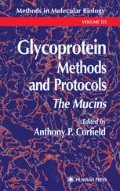Abstract
MUC-type mucins are generally very large glycoproteins. They are encoded by very large mRNAs, and possess polypeptides between 200 and more than 900 kDa(l). The only notable exception is MUC7, which is considerably smaller, i.e. thepolypeptide is only 39 kDa (1). Without exception however, mucins are very heavily Oglycosylated: Up to 50-80% of their molecular mass is due to O-glycosylation (1,2). Moreover, potential N-glycosylation sites are found in virtually all mucin sequences, and in several MUCs N-glycosylation is actually demonstrated (1,2). Human MUC2 for instance contains 30 potential N-glycosylation sites, and if these are all used, the N-glycans together would constitute a molecular mass of about 60 kDa. It is only the very large size of the mature mucins, that makes the amount of N-glycosylation seem insignificant (3). Generally, the sizes of the mature mucins are difficult to estimate; The approximations run from 1 to 20 MDa for single mucin molecules, which hampers many forms of biochemical analysis (3). Also, the extensive glycosylation of mucins results in an intrinsically very heterogeneous population of mature mucins.
Access this chapter
Tax calculation will be finalised at checkout
Purchases are for personal use only
References
Van Klinken B. J. W., Dekker J., Biiller H. A., and Einerhand A. W. C. (1995) Mucin gene structure and-expression updated: protection versus adhesion. Am J Physiol. 269. G613–G627.
Strous G. J., and Dekker J. (1992) Mucin-type glycoproteins. Cnt Rev Biochem Mol Biol. 27, 57–92.
Van Klinken B. J. W., Einerhand A. W. C, Biiller H. A., and Dekker J. (1998) Strategic biochemical analysis of mucins. Anal Biochem. 265, 103–116.
Van Klinken B. J. W., Oussoren E., Weenink J. J., Strous G. J., Biiller H. A., Dekker J., and Einerhand A. W. C. (1996) The human intestinal cell lines Caco-2and LS174T as models to study cell-type specific mucin expression. Glycoconjugate J. 13, 757–768.
Van Klinken B. J. W., De Bolos C, Biiller H. A., Dekker J., and Einerhand A. W. C. (1997) Biosynthesis of mucins (MUC2-6) along the longitudinal axi s of the gastro-intestinal tract. Am J Physiol. 273, G296–302.
Hilkens J. and Buijs F. (1988) Biosynthesis of MAM-6, an epithelial siaolomucin. J. Biol Chem 263, 4215-222.
Tytgat K. M. A. J., Biiller H. A., Opdam F. J. M., Kim Y. S., Einerhand A. W. C, and Dekker J. (1994) Biosynthesis of human colonic mucin: Muc2 is the most prominent secretory mucin. Gastroenterology 107, 1352–1363.
Tytgat K M.A. J., Kbmp L. W. J., Bovelander F. J., Opdam F. J. M., Van der Wurff A., Eineihand A. W. C, Biiller H. A., Strous G. J., and Dekker J. (1995) Preparation of anti-mucin poly peptide anti sera to study mucinbiosynthesis. Anal Biochem. 226, 331–341.
Tytgat K. M. A. X, Opdam F. J. M., Einerhand A. W. C, Biiller K A., and Dekker J. (1996) MUC2 is the prominent colonic mucin expressed in ulcerative colitis. Gut 38, 554–563.
Van Klinken B. J. W., Duits L. A., Verburg M., Tytgat K. M. A. J., Renes I. B., Biiller H. A., Einerhand A. W. C, and Dekker J. (1997) Mouse colonic mucin as a model for human colonic mucin. Ear J Gastroenterol Hepatol 9, A66 (abstract).
Tytgat K.M. A. J., Bovelander F. J., Opdam F.J. M., Einerhand A. W. C, Biiller H. A., and Dekker J. (1995) Biosynthesis of rat MUC2 in colon and its analogy with human MUC2. Biochem J. 309, 221–229.
Klomp L. W. J., Van Rens L., and Strous G. J. (1994) Identification of a human gastric mucin precursor N-linked glycosylation and oligomerization. Biochem J. 304, 693–698.
Dekker J., Van Beurden-Lamers W. M. 0., and Strous G. J. (1989) Biosynthesis of gastric mucus glycoprotein of the rat. J Biol Chem. 264, 10,431–10,437.
Dekker J. and Strous G. J. (1990) Covalent oligomerization of rat gastric mucin occurs in the rough endoplasmic reticulum, is N-glycosylation dependent and precedes O-glycosylation. J Biol Chem. 265, 18,116–18,122.
Dekker J., Van der Ende A., Aelmans P. H., and Strous G. J. (1991) Rat gastric mucin is synthesized and secreted exclusively as filamentous oligomers. Biochem J. 279, 251–256.
Van Klinken B. J. W., Dekker J., Van Gool S. A., Van Marie J., Biiller H. A., and Einerhand A. W. C. (1998) MUC5B is the prominent mucin biosynthesuzed in the human gallbladder mucin and is also expressed in a subset of colonic goblet cells. Am / Physiol. 274, G871–G878.
Klomp L.W. J., Delely A. J., and Strous G. J. (1994) Biosynthesis of human gallbladder mucin. Biochem J. 304, 737–744.
Swallow D. M., Gendler S., Griffiths B., Corney G., Taylor-Papadimitriou J., and Bramwell M. E. (1987) The human tumor-associated epithelial mucins are coded by an expressed hyperviable gene locus PUM. Nature 328, 82–84.
Tytgat K.M. A. J., Van der Wai J. W. G., Biiller H. A., Einerhand A. W. CandDekker J. (1996) Quantitative analysis of MUC2 synthesis in ulcerative colitis, Biochem Biophys Res Comm. 224, 397-05.
Van Klinken B. J. W., Einerhand A. W. C, Buller H. A., and Dekker J. (1998) The oligomerization of a family of four, genetically clustered, human gastrointestinal mucins. Glycobiology 8, 61-15.
Van Kunken B.J.W., Tytgat K.M. A. J., Biiller H. A., Einerhand A. W.C.,and Dekker J. (1995) Biosynthesis of intestinal mucins: MUC1, MUC2, MUC3, and more. Biochem Soc Trans. 23, 814–818.
Klausner R. D., Donaldson J. G., and Lippincott-Schwartz (1992) Brefeldin A: Insights into the control of membrane traffic andorganelle structure. J Cell Biol. 116, 1071–1080.
Author information
Authors and Affiliations
Editor information
Editors and Affiliations
Rights and permissions
Copyright information
© 2000 Humana Press Inc.
About this protocol
Cite this protocol
Einerhand, A.W.C., Van Jan-Willem Klinken, B., Buller, H.A., Dekker, J. (2000). Mucin Precursors Identification and Analysis of Their Intracellular Processing. In: Corfield, A.P. (eds) Glycoprotein Methods and Protocols. Methods in Molecular Biology™, vol 125. Humana Press. https://doi.org/10.1385/1-59259-048-9:249
Download citation
DOI: https://doi.org/10.1385/1-59259-048-9:249
Publisher Name: Humana Press
Print ISBN: 978-0-89603-720-5
Online ISBN: 978-1-59259-048-3
eBook Packages: Springer Protocols

